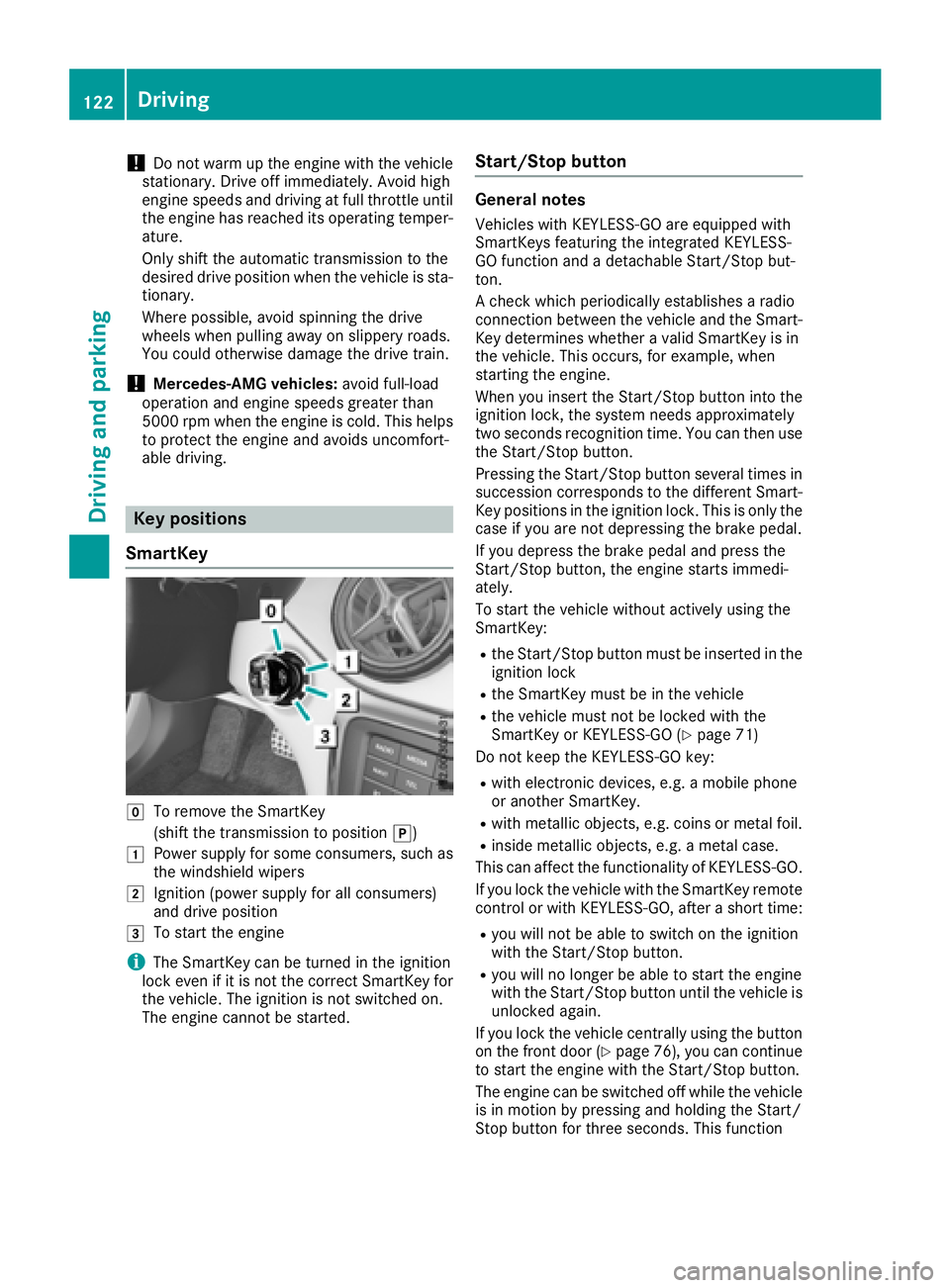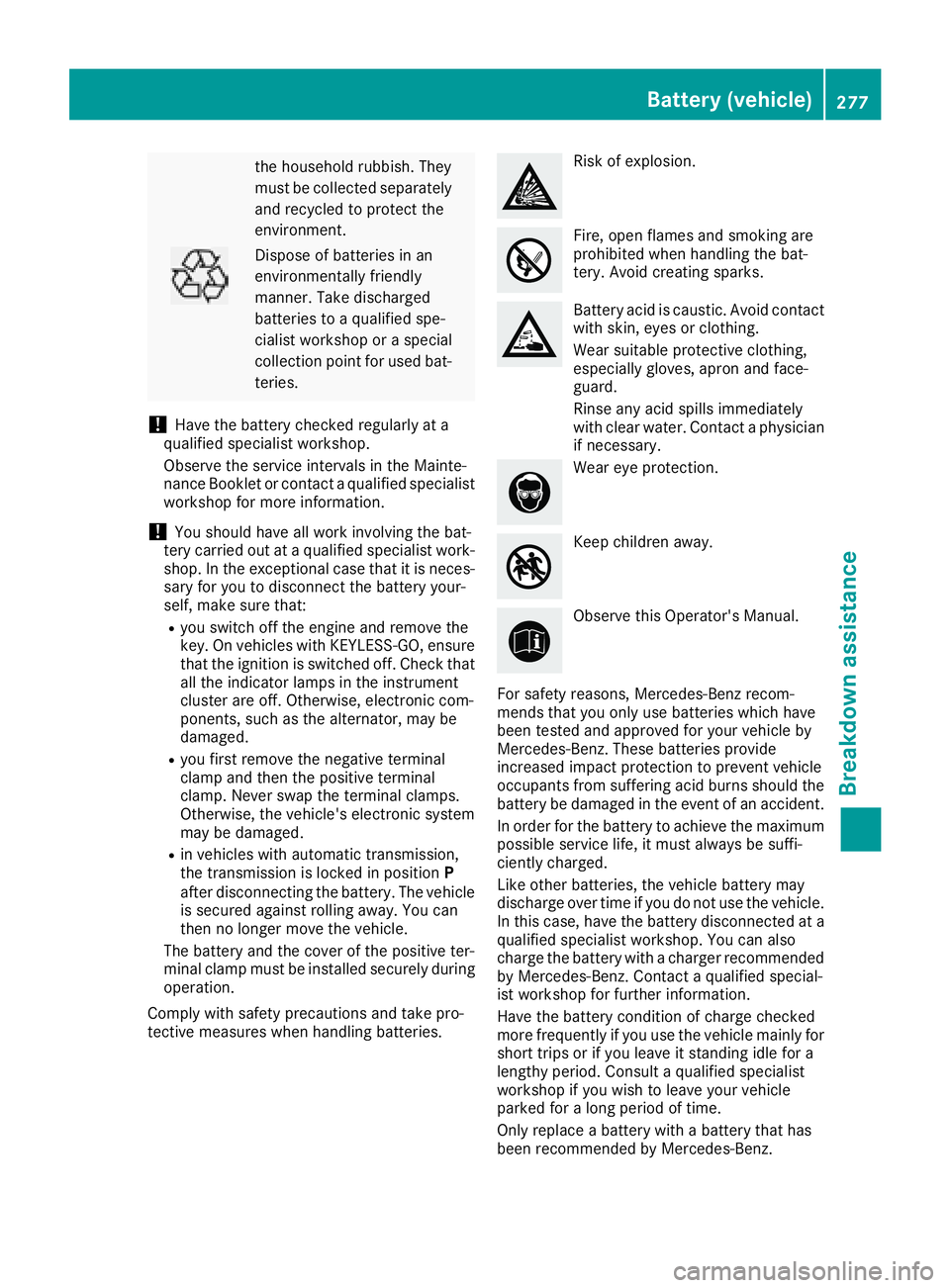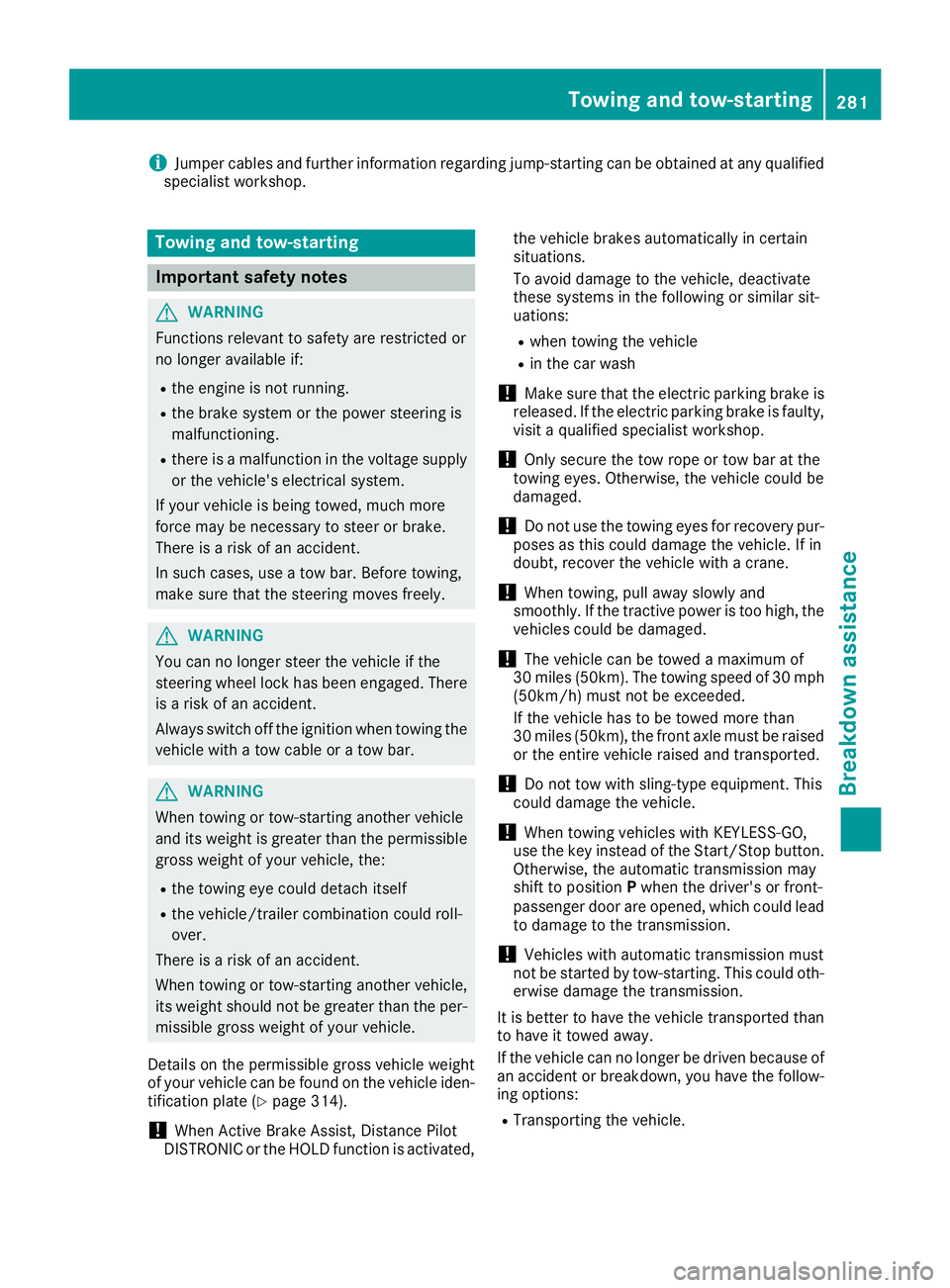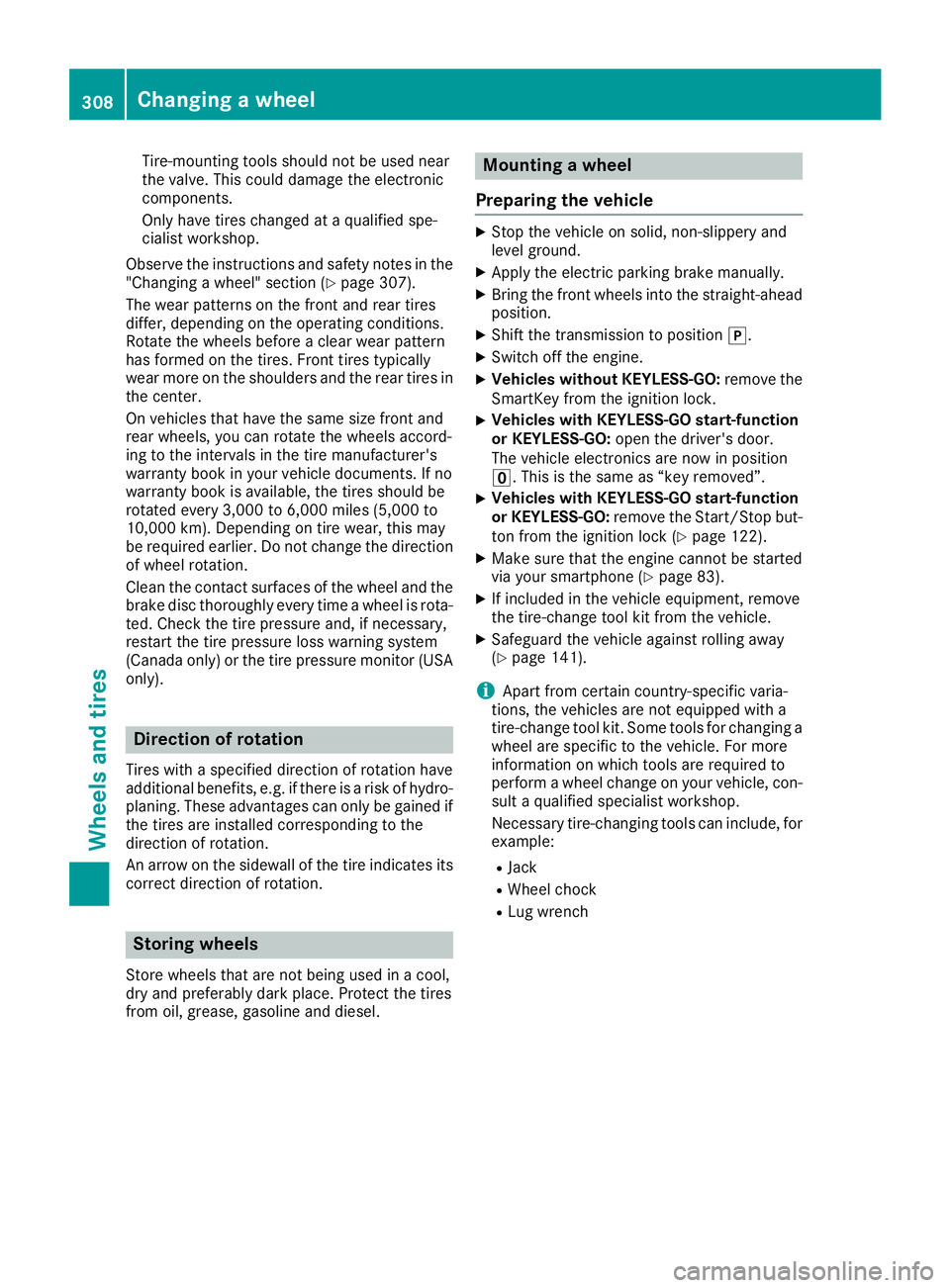2018 MERCEDES-BENZ CLA keyless
[x] Cancel search: keylessPage 124 of 326

! Do not warm up the engine with the vehicle
stationary. Drive off immediately .A void high
engine speeds and driving at full throttle until
the engine has reached its operating temper-
ature.
Only shift the automatic transmission to the
desired drive position when the vehicle is sta-
tionary.
Where possible ,a void spinning the drive
wheels when pulling awa yons lippery roads.
You could otherwise damage the drive train.
! Mercedes-AMG vehicles: avoid full-load
operation and engine speeds greater than
5000 rpm when the engine is cold. This helps
to protect the engine and avoids uncomfort-
able driving.
Key positions
SmartKey
�Z
To remove the SmartKey
(shift the transmission to position �] )�G
Power suppl yf or some consumers, such as
the windshiel dw ipers�H
Ignition (power suppl yf or all consumers)
and drive position
�I
To start the engine
i The SmartKey can be turned in the ignition
lock even if it is not the correct SmartKey for
the vehicle. The ignition is not switched on.
The engine cannot be started. Start/Stop button General notes Vehicles with KEYLESS-GO are equipped with
SmartKeys featuring the integrated KEYLESS-
GO function and ad etachable Start/Stop but-
ton.
Ac heck which periodically establishes ar adio
connection between the vehicle and the Smart-
Key determines whether av alid SmartKey is in
the vehicle. This occurs, for example, when
starting the engine.
When you insert the Start/Stop button into the
ignition lock, the system needs approximately
two seconds recognition time. You can then use
the Start/Stop button.
Pressing the Start/Stop button several times in
succession corresponds to the different Smart-
Key positions in the ignition lock. This is only the
case if you are not depressing the brake pedal.
If you depress the brake pedal and press the
Start/Stop button, the engine starts immedi-
ately.
To start the vehicle without actively using the
SmartKey: R
the Start/Stop button must be inserted in the
ignition lock R
the SmartKey must be in the vehicle R
the vehicle must not be locked with the
SmartKey or KEYLESS-GO ( Y
page 71)
Do not keep the KEYLESS-GO key: R
with electronic devices, e.g. am obile phone
or another SmartKey. R
with metallic objects, e.g. coins or metal foil. R
inside metallic objects, e.g. am etal case.
This can affect the functionality of KEYLESS-GO.
If you lock the vehicle with the SmartKey remote
control or with KEYLESS-GO, after as hort time:R
you will not be able to switch on the ignition
with the Start/Stop button. R
you will no longer be able to start the engine
with the Start/Stop button until the vehicle is
unlocked again.
If you lock the vehicle centrally using the button
on the front door ( Y
page 76), you can continue
to start the engine with the Start/Stop button.
The engine can be switched off while the vehicle
is in motion by pressing and holding the Start/
Stop button for three seconds. This function122
Driving
Driving and parking
Page 279 of 326

the househol dr ubbish .T hey
must be collected separately
and recycle dtop rotect the
environment.
Dispose of batteries in an
environmentall yf riendly
manner. Take discharged
batteries to aq uali fied spe-
cialist workshop or as pe cial
collectio np oi nt for used bat-
teries.
! Hav et he battery checked regularly at a
qualified specialis tw or kshop.
Observe the service intervals in the Mainte-
nanc eB ookle torc ontact aq uali fied specialist
workshop for mor ei nformation.
! Yo us houl dh av ea ll work involvin gt he bat-
tery carrie do ut at aq uali fied specialis tw or k-
shop. In the exceptiona lc as et ha titi sn eces-
sary for yo utod is connect the battery your-
self, make sure that: R
yo us wi tch off the engine and remove the
key .Onv ehicles with KEYLESS-GO, ensure
tha tt he ignition is switched off .C he ck that
al lt he indicator lamps in the instrument
cluste ra re off .O therwise, electronic com-
ponents ,s uc hast he alternator, ma yb e
damaged. R
yo uf irst remove the negative terminal
clamp and the nt he positive terminal
clamp. Never swap the termina lc lamps.
Otherwise, the vehicle' se le ctronic system
ma ybed amaged .R
in vehicles with automatic transmission,
the transmission is locked in position P
after disconnecting the battery .T he vehicle
is secur ed a gainst rolling away .Y ou ca
n
the nnol on ge rm ov et he vehicle.
The battery and the cove roft he positive ter-
minal clamp must be installe ds ec urel yd ur ing
operation.
Compl yw it hs af ety precautions and take pro-
tective measures when handling batteries. Risk of explosion.
Fire, open flames and smoking are
prohibited when handling the bat-
tery .A voi dc reating sparks.
Battery aci disc austic. Avoi dc ontact
with skin, eyes or clothing.
Wear suitabl ep rotective clothing,
especiall yg lo ves, apron and face-
guard.
Rinse any aci ds pills immediately
with clear water. Contact ap hysician
if necessary.
Wear ey ep rotection.
Kee pc hildren away.
Observe thi sO pe rator' sM an ual.
For safety reasons, Mercedes-Benz recom-
mend st ha ty ou onl yu se batteries which have
been tested and approved for your vehicl eb y
Mercedes-Benz. Thes eb at teries provide
increase di mpact protection to prevent vehicle
occupants fro ms uf ferin ga ci db ur ns shoul dt he
battery be damage dint he event of an accident.
In order for the battery to achieve the maximum
possibl es er vice life, it must always be suffi-
ciently charged.
Like othe rb at teries ,t he vehicl eb at tery may
discharge ove rt im eify ou do not us et he vehicle.
In thi sc ase, have the battery disconnecte data
qualified specialis tw or kshop .Y ou can also
charge the battery with ac harge rr ecommended
by Mercedes-Benz. Contact aq uali fied special-
is tw or kshop for furthe ri nformation.
Hav et he battery condition of charge checked
mor ef requentl yify ou us et he vehicl em ai nl yf or
short trip sorify ou leav eits tanding idle for a
length yp er iod. Consult aq uali fied specialist
workshop if yo uw is htol eave your vehicle
parked for al on gp er io doft ime.
Onl yr eplace ab at tery with ab at tery tha th as
been recommended by Mercedes-Benz.Battery (vehicle) 277
Breakdow na ssistance Z
Page 283 of 326

i Jumper cable sa nd further informatio nr egardin gj ump-startin gc an be obtaine data ny qualified
specialist workshop.
Towing and tow-starting
Important safety notes
G WARNING
Function sr elevan ttos afety are restricted or
no longer available if: R
th ee ngine is no tr unning.R
th eb rak es ystem or th ep ower steering is
malfunctioning. R
there is am alfunctio nint he voltage supply
or th ev ehicle's electrical system.
If your vehicle is bein gt ow ed, muc hm ore
force may be necessar yt os te er or brake.
Ther eisar isk of an accident.
In such cases, use at ow bar. Before towing,
mak es ure that th es te ering moves freely.
G WARNING
You can no longer steer th ev ehicle if the
steering wheel loc kh as been engaged. There
is ar isk of an accident.
Always switch off th ei gnitio nw hen towing the
vehicle with at ow cable or at ow bar.
G WARNING
When towing or tow-startin ga nother vehicle
and its weight is greater than th ep ermissible
gross weight of your vehicle ,t he :R
th et ow ing eye could detach itselfR
th ev ehicle/trailer combinatio nc ould roll-
over.
Ther eisar isk of an accident.
When towing or tow-startin ga nother vehicle,
its weight shoul dn ot be greater than th ep er-
missible gross weight of your vehicle.
Details on th ep ermissible gross vehicle weight
of your vehicle can be foun dont he vehicle iden-
tification plat e( Y
page 314).
! When Activ eB ra ke Assist ,D istance Pilot
DISTRONIC or th eH OL Df unction is activated, th ev ehicle brakes automatically in certain
situations.
To avoid damage to th ev ehicle ,d eactivate
these systems in th ef ollowing or similar sit-
uations: R
when towing th ev ehicle R
in th ec ar wash
! Mak es ure that th ee lectric parking brak ei s
released. If th ee lectric parking brak eisf aulty,
visi taq ualifie ds pecialist workshop.
! Only secure th et ow rope or to wb ar at the
towing eyes. Otherwise, th ev ehicle coul db e
damaged.
! Do no tu se th et ow ing eyes for recover yp ur-
pose sast hi sc oul dd amage th ev ehicle .Ifi n
doubt ,r ecover th ev ehicle with ac ra ne.
! When towing ,p ull away slowly and
smoothly. If th et ra ctive power is to oh igh ,t he
vehicle sc oul dbed amaged.
! The vehicle can be towed am aximum of
30 miles (50km). The t owing speed of 30 mph
(5 0km/h) must no tbee xceeded.
If th ev ehicle has to be towed mor et ha n
30 miles (50km), th ef ront axle must be raised
or th ee ntire vehicle raise da nd transported.
! Do no tt ow with sling-type equipment .T his
coul dd amage th ev ehicle.
! When towing vehicle sw ith KEYLESS-GO,
use th ek ey instead of th eS ta rt/Sto pb utton.
Otherwise, th ea utomatic transmission may
shif ttop osition P when th ed river' sorf ront -
passenger door are opened, whic hc oul dl ead
to damage to th et ra nsmission.
! Vehicles with automatic transmission must
no tbes ta rted by tow-starting. This coul do th -
erwis ed amage th et ra nsmission.
It is bette rtoh ave th ev ehicle transported than
to have it towed away.
If th ev ehicle can no longer be driven because of
an acciden torb reakdown ,y ou have th ef ollow-
ing options: R
Transportin gt he vehicle.Towing and tow-starting 281
Breakdown assistance Z
Page 285 of 326
![MERCEDES-BENZ CLA 2018 Owners Manual X
When the vehicle is stationary, depress the
brake pedal and keep it depressed. X
Shift the automatic transmission to position
�] . X
Release the brake pedal. X
Release the electric parking brake. X
MERCEDES-BENZ CLA 2018 Owners Manual X
When the vehicle is stationary, depress the
brake pedal and keep it depressed. X
Shift the automatic transmission to position
�] . X
Release the brake pedal. X
Release the electric parking brake. X](/manual-img/4/59040/w960_59040-284.png)
X
When the vehicle is stationary, depress the
brake pedal and keep it depressed. X
Shift the automatic transmission to position
�] . X
Release the brake pedal. X
Release the electric parking brake. X
Switc ho ff the automatic locking
( Y
page 187). X
Switc hont he hazard warning lamps
( Y
page 102). X
Turn the SmartKey in the ignition lock to posi-
tion �Z and leave the SmartKey in the ignition
lock.
Towing av ehicle with both axles on
the ground It is importan tt hat you observe the safety
instruction sw hen towing away your vehicle
( Y
page 281). X
On vehicles with KEYLESS-GO or the KEY-
LESS-GO star tf unction: you must use the
SmartKey instead of the Start/Stop button
( Y
page 123).
The automatic transmission automatically shifts
to position �] when you open the driver's or
front-passenger door or when you remove the
SmartKey from the ignition lock. In order to
ensure that the automatic transmission stays in
position �\\ when towing away the vehicle, you
must observe the following points: X
Make sure that the vehicle is stationary. X
Turn the SmartKey to position �H in the igni-
tion lock. X
Depress and hold the brake pedal. X
Shift the automatic transmission to position
�\\ . X
Leave the SmartKey in position �H in the igni-
tion lock. X
Release the brake pedal. X
Release the electric parking brake. X
Switc hont he hazard warning lamps
( Y
page 102).
i In order to signal ac hange of direction when
towing the vehicle with the hazard warning
lamps switched on, use the combination
switch as usual. In this case, only the indicator
lamps for the direction of travel flash. After resetting the combination switch, the hazard
warning lamp start sf lashing again.
Transporting the vehicle
4MATIC vehicles or vehicles with auto-
matic transmission
! When the vehicle is loaded for transport, the
fron ta nd rear axles must be stationary and on
the same transportation vehicle. Positioning
over the connection point of the transport
vehicle is not permitted. The drive train may
otherwise be damaged.
All vehicles
! You may only secure the vehicle by the
wheels, not by parts of the vehicle such as
axle or steerin gc omponents. Otherwise, the
vehicle could be damaged. X
Turn the SmartKey to position �H in the igni-
tion lock ( Y
page 122). X
Shift the transmission to position �\\ .
As soon as the vehicle has been loaded: X
Preven tt he vehicle from rolling away by
applying the electric parking brake. X
Shift the transmission to position �] .X
Turn the SmartKey to position �Z in the igni-
tion lock and remove it. X
Secure the vehicle.
The towing eye can be used to pull the vehicle
ont oat railer or transporter for transportin gp ur-
poses.Towing and tow-starting 283
Breakdown assistance Z
Page 286 of 326

Note son4 MATIC vehicles
! Vehicle sw it h4 MATIC must not be towed
with eithe rt he front or the rea ra xl er aised, as
doing so will damage the transmission.
Vehicle sw it h4 MATIC ma yo nl ye it he rbet owed
away with both axles on the ground or be loaded
up and transported.
If the vehicle' st ransmission, front, or rea ra xl ei s
damaged, have the vehicl et ransporte dona
truck or trailer.
In the even to fd amag etot he electrical sys-
tem:
If the battery is defective, the automatic trans-
mission will be locked in position �] .Tos hift the
automatic transmission to position �\\ ,y ou
must provide powe rtot he vehicle' so n-board
electrica ls ys te mint he same wa yasw he nj ump-
starting ( Y
page 278).
Have the vehicl et ransporte donat ransporte ro r
trailer.
Tow-startin g( em ergency engine
starting)
! Vehicle sw it ha ut omatic transmission must
not be tow-started .Y ou could otherwis ed am -
ag et he automatic transmission.
i Yo uc an find information on "Jump-starting"
under ( Y
page 278).
Fuses
Important safety notes
G WARNING
If yo um an ipulate or bridg eaf aulty fuse or if
yo ur eplace it with af us ew it hah ighe ra mper -
age, the electric cable sc ould be overloaded.
This could resul tina fire. There is ar is kofa n
accident and injury.
Alway sr eplace faulty fuse sw it ht he specified
new fuse sh avin gt he correc ta mperage.
! Onl yu se fuse st ha th av eb ee na pp roved for
Mercedes-Benz vehicles and which have the
correc tf us er at ing for the syste mc oncerned.
Onl yu se fuse sm ar ked with an "S" .O ther- wise ,c omponents or systems could be dam-
aged.
! Make sure tha tnom oisture can ente rt he
fuse bo xw he nt he cover is open.
! When closing the cover, make sure tha titi s
lying correctly on the fuse box. Moistur es eep-
ing in or dirt could otherwis ei mpair the oper-
ation of the fuses.
Th ef uses in your vehicl es er ve to close down
faulty circuits .Ifa fuse blows, al lt he compo-
nents on the circuit and their functions stop
operating.
Blown fuse sm us tber eplaced with fuse soft he
same rating ,w hi ch yo uc an recognize by the
color and value. Th ef us er at ing sa re liste dint he
fuse allocation chart.
Th ef us ea lloc at io nc h art is in the fuse bo xi nt he
front-passenge rf ootwell ( Y
page 285).
If an ewly inserte df us ea ls ob lows ,h av et he
cause traced and rectifie dataq ualified special-
is tw or kshop ,e .g .ana ut horized Mercedes-Benz
Center.
Before changin gaf use X
Secure the vehicl ea gain st rolling away
( Y
page 141). X
Switch off al le le ctrica lc onsumers.X
Vehicle sw it hout KEYLESS-GO: remove the
SmartKe yf ro mt he ignition lock. X
Vehicle sw it hK EYLESS -G Os tart-function
or KEYLESS-GO: open the driver's door.
Th ev ehicl ee le ctronics ar en ow in position
�Z .T hi sc orresponds to the SmartKe yb ei ng
remove df ro mt he ignition.
Th ef uses ar el oc ated in variou sf us eb ox es:R
Fuse bo xint he engine compartment on the
left-hand side of the vehicle, when viewed in
the directio noft ravel R
Fuse bo xint he front-passenge rf ootwell
Th ef us ea lloc atio nc hart is on the fuse bo xint he
front-passenge rf ootwell ( Y
page 285).284
Fuses
Breakdow na ssistance
Page 310 of 326

Tire-mounting tools should not be used near
the valve. This could damage the electronic
components.
Only have tires changed at aq ualified spe-
cialist workshop.
Observe the instructions and safety notes in the
"Changing aw heel" section ( Y
page 307).
The wear pattern sont he front and rear tires
differ, depending on the operating conditions.
Rotate the wheels before ac lear wear pattern
has formed on the tires. Fron tt ires typically
wear more on the shoulders and the rear tires in
the center.
On vehicles that have the same size front and
rear wheels, you can rotat et he wheels accord-
ing to the intervals in the tire manufacturer's
warranty book in your vehicle documents. If no
warranty book is available, the tires should be
rotated every 3,000 to 6,000 miles (5,000 to
10,00 0k m) .D ependin gont ire wear, this may
be required earlier. Do not change the direction
of wheel rotation.
Clean the contact surfaces of the wheel and the
brake disc thoroughly every time aw heel is rota-
ted. Check the tire pressure and, if necessary,
restart the tire pressure loss warning system
(Canada only) or the tire pressure monitor (USA
only).
Direction of rotation Tires with as pecified direction of rotation have
additional benefits ,e .g. if there is ar isk of hydro-
planing. These advantages can only be gained if
the tires are installed corresponding to the
direction of rotation.
An arrow on the sidewall of the tire indicates its
correc td irection of rotation.
Storing wheels Stor ew heels that are not being used in ac ool,
dry and preferably dark place. Protec tt he tires
from oil, grease, gasoline and diesel. Mounting aw heel
Preparing the vehicle X
Stop the vehicle on solid, non-slippery and
level ground. X
Apply the electric parking brake manually. X
Bring the front wheels into the straight-ahead
position. X
Shift the transmission to position �] .X
Switch off the engine. X
Vehicles without KEYLESS-GO: remove the
SmartKey from the ignition lock. X
Vehicles with KEYLESS-GO start-function
or KEYLESS-GO: open the driver's door.
The vehicle electronics are now in position
�